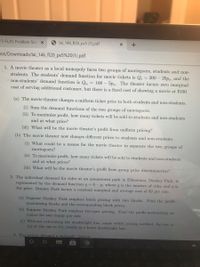
ENGR.ECONOMIC ANALYSIS
14th Edition
ISBN: 9780190931919
Author: NEWNAN
Publisher: Oxford University Press
expand_more
expand_more
format_list_bulleted
Question
Question 1 part a please

Transcribed Image Text:15-FL20: Problem Set X
lai_146 fl20_ps5 (1).pdf
fos/Downloads/lai_146_fl20_ps5%20(1).pdf
1. A movie theater as a local monopoly faces two groups of moviegoers, students and non-
students. The students' demand function for movie tickets is Qs = 200 – 20ps, and the
* non-students' demand function is Qn = 100 – 5p,. The theater incurs zero marginal
cost of serving additional customer, but there is a fixed cost of showing a movie at $100.
(a) The movie theater charges a uniform ticket price to both students and non-students.
(i) Sum the demand functions of the two groups of moviegoers.
(ii) To maximize profit, how many tickets will be sold to students and non-students
and at what price?
(iii) What will be the movie theater's profit from uniform pricing?
(b) The movie theater now charges different prices to students and non-students.
(i) What could be a means for the movie theater to separate the two groups of
moviegoers?
(ii) To maximize profit, how many tickets will be sold to students and non-students
and at what prices?
(iii) What will be the movie theater's profit from group price discrimination?
2. The individual demand for rides at an amusement park in Ellentown, Donkey Park, is
represented by the demand function q = 8- p, where q is the number of rides and p is
the price. Donkey Park incurs a constant marginal and average cost of $2 per ride.
(a) Suppose Donkey Park employs block pricing with two blocks. Find the profit-
maximizing blocks and the corresponding block prices.
(b) Suppose Donkey Park employs two-part pricing. Find the profit-maximizing en-
trance fee and charge per ride.
(c) Without calculating the deadweight loss, argue which pricing method, the one in
(a) or the one in (b), results in a lower deadweight loss.
3. The inverse demand a monopoly faces is
1O
Expert Solution
This question has been solved!
Explore an expertly crafted, step-by-step solution for a thorough understanding of key concepts.
This is a popular solution
Trending nowThis is a popular solution!
Step by stepSolved in 3 steps

Knowledge Booster
Learn more about
Need a deep-dive on the concept behind this application? Look no further. Learn more about this topic, economics and related others by exploring similar questions and additional content below.Similar questions
- 8 Write an email (120-150 words) to ask for • information about an activity that you would like to do. Use an idea from the list or your own idea. Follow the content checklist and remember to use indirect questions. a course at a college or with a one-to-one tutor a sport / activity at a gym joining a volunteering group Checklist • how you heard about the course / activity/group ⚫ the days and times ⚫ the cost if you need any experience / skills • if you need any equipmentarrow_forwardImagine you are the mayor of a town and you are trying to decide if you should pay for a fireworks show. Your staff survey your 400 citizens who say that they each value a fireworks show at $10. The fireworks show only costs $3,000 so you put on the show but when you ask for donations to pay for the fireworks you only receive $25 total. What does this result show? Select an answer and submit. For keyboard navigation, use the up/down arrow keys to select an answer. You staff's survey must have overestimated the value of a fireworks show. b The fireworks cost must have been greater than their economic benefit. The firework show suffered from the Tragedy of the Commons problems d The town's citizens were free-riders.arrow_forwardPlease answer question Darrow_forward
arrow_back_ios
SEE MORE QUESTIONS
arrow_forward_ios
Recommended textbooks for you

 Principles of Economics (12th Edition)EconomicsISBN:9780134078779Author:Karl E. Case, Ray C. Fair, Sharon E. OsterPublisher:PEARSON
Principles of Economics (12th Edition)EconomicsISBN:9780134078779Author:Karl E. Case, Ray C. Fair, Sharon E. OsterPublisher:PEARSON Engineering Economy (17th Edition)EconomicsISBN:9780134870069Author:William G. Sullivan, Elin M. Wicks, C. Patrick KoellingPublisher:PEARSON
Engineering Economy (17th Edition)EconomicsISBN:9780134870069Author:William G. Sullivan, Elin M. Wicks, C. Patrick KoellingPublisher:PEARSON Principles of Economics (MindTap Course List)EconomicsISBN:9781305585126Author:N. Gregory MankiwPublisher:Cengage Learning
Principles of Economics (MindTap Course List)EconomicsISBN:9781305585126Author:N. Gregory MankiwPublisher:Cengage Learning Managerial Economics: A Problem Solving ApproachEconomicsISBN:9781337106665Author:Luke M. Froeb, Brian T. McCann, Michael R. Ward, Mike ShorPublisher:Cengage Learning
Managerial Economics: A Problem Solving ApproachEconomicsISBN:9781337106665Author:Luke M. Froeb, Brian T. McCann, Michael R. Ward, Mike ShorPublisher:Cengage Learning Managerial Economics & Business Strategy (Mcgraw-...EconomicsISBN:9781259290619Author:Michael Baye, Jeff PrincePublisher:McGraw-Hill Education
Managerial Economics & Business Strategy (Mcgraw-...EconomicsISBN:9781259290619Author:Michael Baye, Jeff PrincePublisher:McGraw-Hill Education


Principles of Economics (12th Edition)
Economics
ISBN:9780134078779
Author:Karl E. Case, Ray C. Fair, Sharon E. Oster
Publisher:PEARSON

Engineering Economy (17th Edition)
Economics
ISBN:9780134870069
Author:William G. Sullivan, Elin M. Wicks, C. Patrick Koelling
Publisher:PEARSON

Principles of Economics (MindTap Course List)
Economics
ISBN:9781305585126
Author:N. Gregory Mankiw
Publisher:Cengage Learning

Managerial Economics: A Problem Solving Approach
Economics
ISBN:9781337106665
Author:Luke M. Froeb, Brian T. McCann, Michael R. Ward, Mike Shor
Publisher:Cengage Learning

Managerial Economics & Business Strategy (Mcgraw-...
Economics
ISBN:9781259290619
Author:Michael Baye, Jeff Prince
Publisher:McGraw-Hill Education